Scientific research on the North Sea or on the Arctic Sea, the similarities are striking! Passionate scientists want to understand how the sea works to be as well prepared as possible for the changes that the world is experiencing. A report of 9 days on board of the Polish oceanographic research vessel Oceania.
RV Belgica and RV Oceania
Just like Belgium, Poland has its own research vessel. The three-master RV Oceania is property of the Polish Institute for Oceanographic Research (IOPAN) and has approximately the same age (°1985) and length (just under 50 m) as our own RV Belgica. The vessel is mainly used for scientific research in the Baltic Sea. Once a year, however, it leaves for the far north to study the impact of climate change on the Arctic Sea in the fjords of Svalbard. From Wednesday 26 July to Friday 4 August 2017, the 24 Polish crew members were accompanied by a Canadian journalist, and the Belgian science communicator Sigrid Maebe.
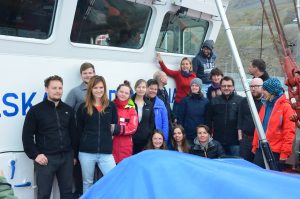
The RV Oceania captain, Piotr Woźniak, knows our RV Belgica well. In the nineties he took part in the festivities of the Belgian Navy in Zeebrugge, where his military vessel docked next to RV Belgica. Also when the 100th anniversary of the scientific expedition of the old Belgica to Antarctica was celebrated, in 1997 in Antwerp, he visited our research vessel. Both vessels are very similar, but the fact that RV Oceania is a sailing ship, and therefore has a narrower hull, leads to a tighter barge.
RV Oceania is equiped with all possible equipment to take water samples, collect organisms (plankton in the water column or benthos on the seabed), or to optically characterise the water colour which allows to determine the properties of the water. Due to the limited space, the Polish scientists can only collect samples and freeze or fix them, but they cannot study them on board. Later, on land, they will need half a year to a year to analyse all the samples of this campaign.
Research in Hornsund fjord
For this scientific cruise ‘AREX’2017’ (Arctic Expedition 2017), RV Oceania left Poland mid-June, to sail all along Norway to the island group of Svalbard. At the end of August, 80 days later, the vessel will arrive back in Poland with hundreds of samples and measurements. Then the number “30”, which is painted next to a polar bear on the side of the vessel, will also be changed: the 31st voyage of RV Oceania to Svalbard will be completed!

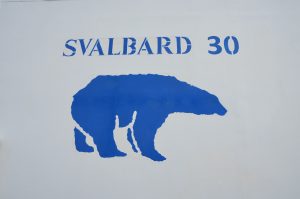
I boarded RV Oceania in Longyearbyen, the capital of Svalbard, for a 9-day scientific cruise to the Hornsund Fjord. The aim of this part of the journey was to investigate how far the influence of the Atlantic Ocean in this fjord in the southern part of Svalbard can be felt. The Hornsund Fjord is actually the first area where Atlantic water from the south enters the Arctic Sea. Year after year, the chief scientist Sławomir Kwaśniewski sees the Atlantic water penetrate deeper into the fjord, while the seawater gets noticably warmer. The plankton community is also shifting: Atlantic species of copepods, jellyfish and sea gooseberries are more often observed in the fjord. The entire ecosystem changes with the supply of this warmer water. The scientists are therefore very happy when they also find real Arctic species in their plankton net. This annual survey by the IOPAN Institute provides a long time series with measurements and analyses that are indispensable for understanding the effects of climate change.
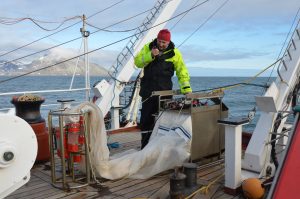
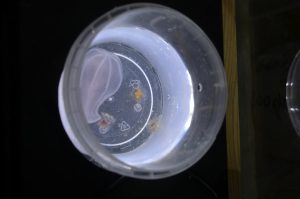
Polar Station
The Polish government also has a research station on land in Svalbard: the Polish Polar Station, also in the Hornsund fjord. It is a magical place, but walking in the neighbourhood is not possible without a firearm because you always have to be prepared for a meeting with a polar bear (Ursus maritimus)! During the summer months, about 30 scientists and technicians are stationed here, in the dark winter months only a dozen. They investigate the glacier that is actually in their backyard. Furthermore, they constantly measure the magnetic radiation and meteorological conditions of the area and study the living conditions and the eating pattern of the colony of little auks (Alle alle, a funny flying seabird species).
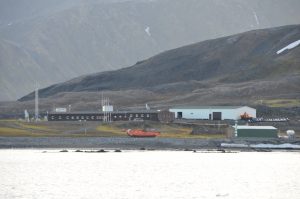
The two “paparazzi”, as the journalist and I were laughingly referred to, were allowed to go ashore for one day to get to know the scientists Danek and Kasia. That morning they checked the batteries of the cameras that were placed at the nests to register how the parents come to feed the chicks. The chicks themselves are under a pile of stones and you cannot see them on the camera images. In the afternoon, the researchers caught a number of adult birds to collect food samples. For this, they “spoon” the freshly caught plankton from the crop of the little auks. Apparently the chicks are mainly fed with a certain larval stage (stage 5) of the plankton species Calanus glacialis. It is unbelievable how these birds, under water, can distinguish the different plankton stages. And also aim well enough to catch them!
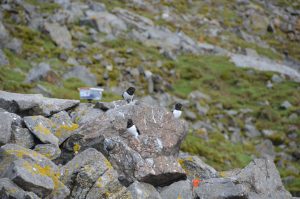
RBINS-researchers
In the station I also met Alexandra, who studies several glaciers in the Hornsund fjord with a sonar. She spends hours in a small boat, right next to the glacier, in order to get a ‘picture’ of the part of the glacier that is submerged, using sound waves. Alexandra is Polish, lives and works in Italy and knew the work of a number of OD Nature colleagues (Vera Van Lancker and Giacomo Montereale Gavazzi) who do similar research with sonars, but targeting the bottom of the Belgian part of the North Sea. Joana, who came on board for the next part of the cruise, also had good contacts with RBINS scientists who study crustaceans (Claude De Broyer and Cédric d’Udekem d’Acoz). And so the good reputation of the RBINS researchers, also so far from home, is proven again!
Polar bear, whales, plankton
Apparently we were very lucky during the 9-day trip. This was partially due to the beautiful weather (sun, little wind, and a nice 5 ° C). The weeks before there was only fog in the fjord and heavy wind on the high seas, making it difficult to collect samples and completely hiding the overwhelming view! We also saw a polar bear in one of the smaller bays. He had feasted on a large prey, the remains of which were still on an ice floe. It was a mighty sight: a polar bear that slipped from an iceberg into the seawater and – surprisingly quickly – swam away from us, moving his head from left to right, as if he wanted to smell how far or near the human danger was. Even the seasoned Svalbard scientists were happy with this unique encounter!
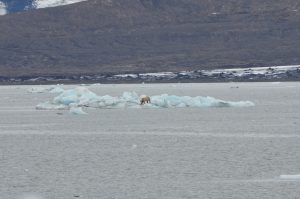
In the fjord a humpback whale (Megaptera novaeangliae) revealed its presence twice. He had found a place in the fjord, close to a glacier, that was teeming with nutritious plankton. So why move?
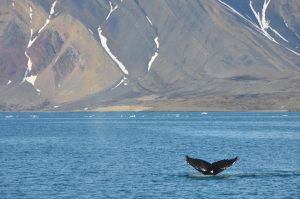
More whales were spotted in the high seas (1000 meters deep!), where we carried out continuous optical measurements in the water for 48 hours. How fine it was to collect water samples at 3 o’clock in the morning, and hear and see how whales or dolphins pass by our ship! It was quite a challenge to force myself to go to sleep in the evening, and risk missing beautiful sceneries and whales. The pros and cons of the eternal Nordic sun at this time of the year!
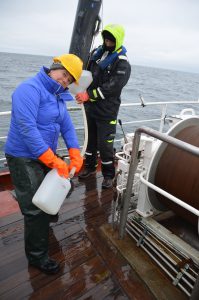
Unspoiled nature?
The life on board of RV Oceania was strikingly similar to that on board of RV Belgica (except the Polish language, that is a big challenge!). Fresh soup every day, an ice cream every now and then, small but cozy cabins, and every day the challenge to take a shower and get dressed in small spaces that move from front to back and from left to right … The big difference only becomes obvious when you are outside, on the deck. No grey horizon full of ships on one side, and coastal apartment buildings on the other. On the high seas you only see a grey horizon without ships, while the fjords feature incredibly beautiful sunlit views of hills and mountains, eternal snow and the not so eternal glaciers. The glaciers are getting smaller at a terrifying speed. The sea charts in the bridge of RV Oceania were updated in 2014, and again turned out to be no longer correct! Shocking to realise how untouched nature changes as a result of the ill-considered behaviour of people thousands of miles away …
The images of fantastic surroundings, mountains, glaciers, birds, plankton, whales and the polar bear are forever imprinted in my memory and I will continue to encourage people to learn to understand climate change and take it seriously! Do not hesitate to join us!
Text and images: Sigrid Maebe
More information on IOPAN, RV Oceania, and the research they are involved in can be consulted here. RV Oceania will leave Poland for ‘AREX’2018’ – the 32nd voyage of RV Oceania to Svalbard – on 14 June 2018, only to return on 29 August (schedule of RV Oceania in 2018).
